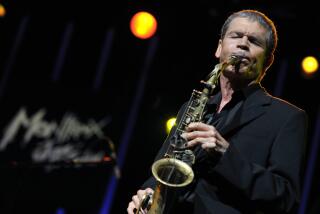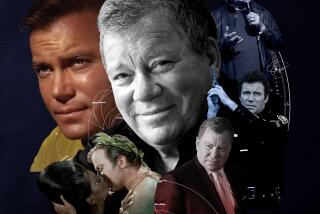JAZZ REVIEW : Sax Great David Sanborn Invigorates, Disappoints
- Share via
David Sanborn may have been the most influential alto saxophonist of the ‘70s and early ‘80s. A generation of young players--Marc Russo (of the Yellowjackets), Brandon Fields and Sam Riney are only a few who come to mind--was deeply affected by Sanborn’s soaring high notes and blues-honed melodies.
Like Stan Getz in the ‘50s, Sanborn’s influence has flowed from his capacity to popularize. Both musicians developed playing styles that smoothed the edges of rich, aesthetically dense music identified with older black players into more easily grasped translations of the originals. In Getz’s case, the earlier model was Lester Young; in Sanborn’s, it was the blues-styled alto saxophonist Hank Crawford. Each translation fascinated more in its early manifestation than it has over the long haul.
Sunday night at the Pacific Amphitheatre, Sanborn displayed the present status of his skills first-hand before an enthusiastic audience of about 6,500.
He divided the program fairly equally between older material and songs from a current album, “Close Up.” With the possible exception of a rousing piece entitled “Slam,” the older material was far better, igniting considerably more improvisational sparks in Sanborn’s solos.
Wisely, he abandoned the incessant high-note cries that dominate virtually every track of the studio effort, and, on pieces like “As We Speak,” dug deeply into the multi-note swoops and flourishes that are the meat and potatoes of his style.
Guitarist Hiram Bullock, working alongside Sanborn as a near-equal, front-line soloist, brought a highly entertaining visual energy to the program. On a feature number that included bits and pieces of “Round Midnight” and “Don’t Get Around Much Anymore,” he roved through the audience with his instrument, impressive with his vigorous athleticism, if not always with his music.
Keyboardist Ricky Peterson’s work, less visually spectacular, nonetheless did a bit more to tickle the brain, while bassist Steve Logan, percussionist Don Alias and drummer Terry Lynn Carrington laid down an unrelentingly foot-tapping pulse.
Invigorating though it may have been, the primary problem with Sanborn’s music was that it simply didn’t go anyplace. Whatever motion and change it showed was almost always generated by a calculated shift of gears from the rhythm section. And even those route changes were simply moves from one funk freeway to another.
The Pacific Amphitheatre concert was the final stop of a 2 1/2-month tour, and Sanborn may be well-advised to take a break and give a little consideration to his musical direction.
With four Grammys on his shelf, regular appearances on “Late Night With David Letterman” and his own weekly radio program, “The Jazz Show,” he seems to have it all. But his current level and style of performance--both in Sunday night’s program and in the new album--successful though it may be in a commercial sense, leads one to wonder how many young saxophonists are being influenced by today’s David Sanborn.
More to Read
The biggest entertainment stories
Get our big stories about Hollywood, film, television, music, arts, culture and more right in your inbox as soon as they publish.
You may occasionally receive promotional content from the Los Angeles Times.








